
It’s been a stellar year for Seba Calfuqueo (Mapuche,) a multi-disciplinary contemporary artist from Chile. She has captured the attention and acclaim of curators, critics, and collectors at some of the most eminent and influential art forums, including the Whitney Biennial, Venice Biennale, and Bienal de São Paolo, while her work has been acquired by the Tate Modern, Denver Museum of Art, Centre Pompidou, and other prestige collections. An Indigenous trans woman, she belongs to the first generation of urban Mapuche; born in and rising up from the city of Santiago, from which her vision now extends far beyond.
Cristina Verán recently spoke with Calfuqueo following Art Week Miami, where she was a celebrated stand-out at Art Basel Miami Beach, NADA (New Art Dealers Alliance) Miami, and featured in the group exhibition "See Me, Hear Me: Native Cultures at ArtNexus Space."
CV: First, given how strong the push toward assimilation can be in South American cities for Indigenous Peoples, how did your family retain (and also pass on to you) a sense of being Mapuche after having left their place of origin?
SC: My parents and grandparents always made it known that we are Mapuche and that I belong to the Mapuche Peoples—our Indigenous surname, Calfuqueo, is a clear mark of that. In Chile, alas, such names can stigmatize and relegate a person to a social realm typically associated with poverty, as well as limit one’s opportunities for mobility.
My grandmother had left her community to look for work in Santiago when she was just seven years old and alone,, not knowing Spanish or understanding the customs of the non-Indigenous world. She had little choice other than to be a domestic worker; the kind of job that Mapuche migrants were expected to occupy. This was typical, historically, of the urbanizing Mapuche experience.
Despite such limitations, she, like other Mapuche in the city, continued to live according to very strong cultural practices. My grandparents found ways to resist colonization by, for example, continuing to speak our language, Mapudungun.
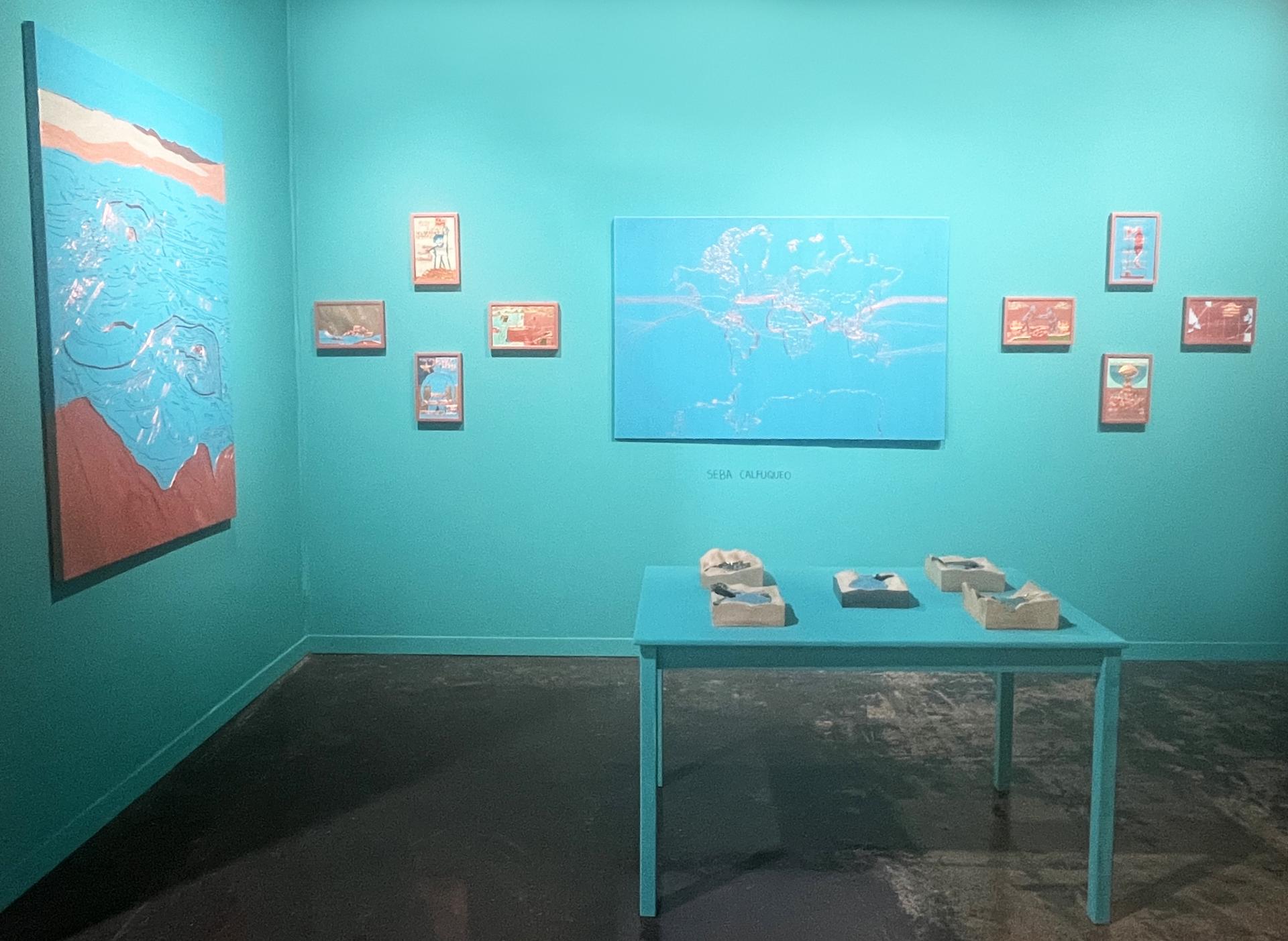
Galería Patricia Ready featured Calfuqueo’s commentaries on copper mining, in its “La Sombra de Nuestro Tiempo” (The Shadow of Our Time) exhibition at NADA (New Art Dealers Alliance) in Miami. Photo by Cristina Verán.
CV: Was this only in the home, or used throughout their daily lives, externally as well?
SC: It was spoken only among themselves, not in public arenas. Cultural spaces were very closed like that; not shared with outsiders.
CV: At what point did you come to understand and thereafter define how you, yourself would bear a direct responsibility for a manner of cultural assertion and continuation?
SC: I was about to turn 18 when my grandmother died, and it was a strong wound to me. In that moment, I became not only an adult, but also aware that the ancestral knowledge she’d always carried with her—as the last person in my family who spoke the language completely—had just been lost. My conscience told me, very clearly, to do whatever I could to recover it, and to collectivize the process so that it would become something through which to build my own kind of community; one comprising not only the family I was born to, but also others I could choose.
CV: What would be especially helpful to understand about Mapuche history, its distinctiveness, that speaks to who your people are today?
SC: Our colonization experience was quite different from that of other Indigenous Peoples in South America. In the 17th century, we were officially recognized by the Spanish Crown as an autonomous, sovereign people, and they agreed not to occupy our lands, from the Bíobío River on down. Things changed after 1860 however, when (by-then independent) Chile and Argentina carried out concurrent military campaigns—the so-called Pacification of Araucanía in the former, and what was known as the Conquest of the Desert in the latter—to annex Mapuche territories.
Our Indigenous reality is forever linked to that colonial reality, in battle and struggle, coexisting and contaminating each other. There is a constant reinvention of what tradition is and can mean for Mapuche; a way of being that I think has helped us continue to exist. We live not in a static past but in this moment and for the future, within a perpetual cross-contamination—which I don’t see as inherently negative. My country’s mainstream culture has had a great influence on our world, just as we have had on it—from the foods we all eat to the words we all use. Mapuche in Santiago today assert not only their Indigenous identity, but claim an identity from the city itself, too.
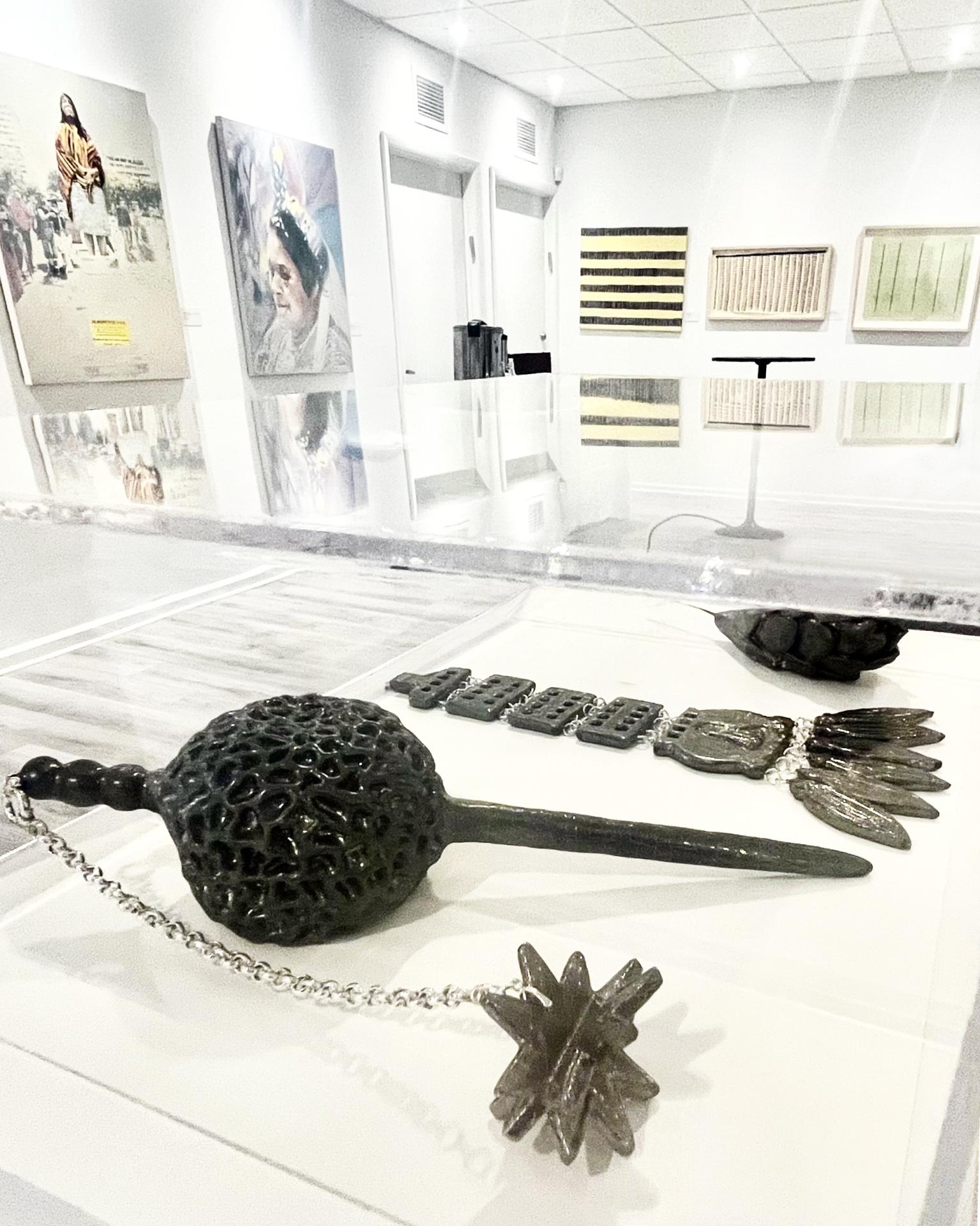
Pieces from Calfuqueo's “Destellos” (Flashes) series at “See Me, Hear Me: Native Cultures,” a group exhibition of Indigenous Artists of the Americas, at ArtNexus Space Miami. Photo by Cristina Verán.
CV: From this “contamination” you note, what if anything have you found creatively useful, perhaps even meaningful, to have come out of it?
SC: Well, consider our silver jewelry; it’s iconic for Mapuche, right? But silversmithing was introduced to us during the era of colonization; something foreign. Our People took to it then, and made it their own.
Similarly, rapping was not born of our world, but there are many Mapuche exponents of hip hop today who use our Mapudungun language to rap, as a form of resistance, about important issues and political things.
CV: What first sparked your interest in art, and making art to speak to these histories in a visual way? Was this something your family imparted to you?
SC: I studied art at the University of Chile. My parents (who never finished high school) and my grandparents (who did not complete primary school) experienced very different situations and lives as compared to my own. They didn’t have much to do with art, so we didn't go to museums, we didn't visit galleries or anything like that when I was growing up. I do remember there being some in my family who made textiles or had other types of creative cultural practices, though.
When I got to high school though, I met an art teacher named Joanna Berríos who greatly impacted my life. Between the ages of 14 to 18, she planted the seed of art in me, inspiring me to study it at the University of Chile, making me want to do what I do today.
CV: That’s wonderful. Has this relationship continued?
SC: Yes, in fact we now work together! She is my right-hand woman, my producer.
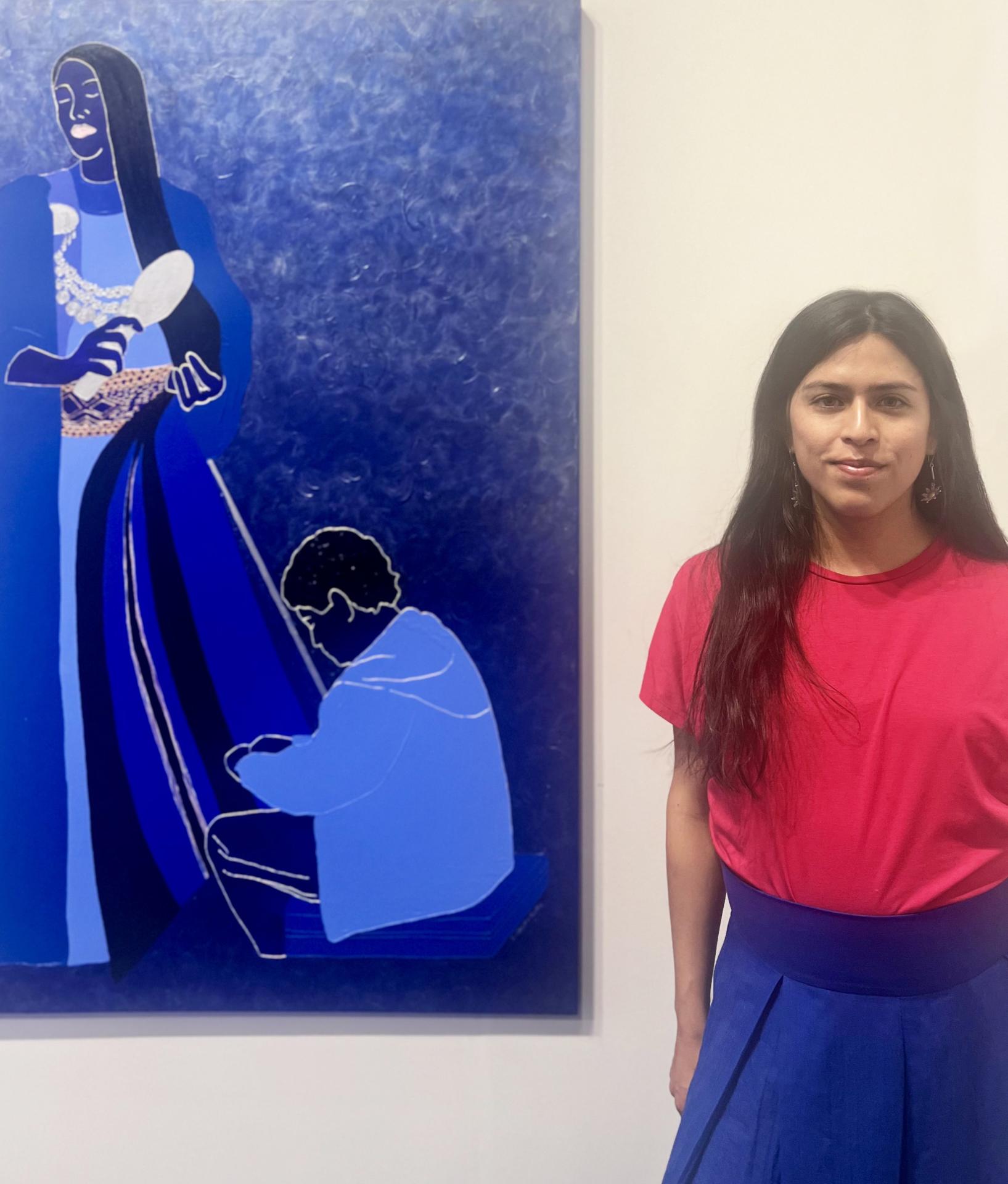
Seba Calfuqueo with "Tejedor de la imagen, Tecnologías de la imagen" (Weaver of the Image, Technologies of the Image), featured in her solo exhibition with Galeria Marilia Razuk of São Paolo at Art Basel Miami. Photo by Cristina Verán.
CV: You are an artist, you are Mapuche, and you are a trans woman. How would you say the latter two identities impact and inform the first?
SC: Identifying as Mapuche is a political claim against the colonial state; one that I enact through art. My art speaks to more than just my Indigenous identity or my trans identity though; its power is beyond all of that. These layers are always intertwined, connected and dialoguing with each other. They cannot be separated, either from one another or from the art that I make.
Some of my works don’t speak explicitly of anything Mapuche at all, while others reimagine what being Mapuche even is, or what else it could mean to be thus.
CV: In “reimagining what could be” with your art, how do you approach and articulate this vision—and how has this (and perhaps even you) evolved over time ?
SC: Each artist creates a new kind of language, one that is distinctly their own. I think about crossing boundaries and transgressing the limitations inherent in “traditional” notions of what a Mapuche person would do or could be, both in how we are represented by others and what we ourselves are allowed to do as creators. I use a variety of technologies in my practice, including making 3D-printed and digital artworks. I also work with the body, doing performance art, through which I am able to bring forth sensory experiences of light, color, sound, and smell. All the senses come into play.
How I present myself has been a real journey throughout, and has changed over time. My art has reflected the transition; an ever-mutating story.
CV: You mention your performance side, which I first experienced, live, via Bodies in Resistance/ Iñche ta Kangechi (I Am the Otherness), presented for the Indigenous-led Knowledge of Wounds series at Performance Space New York (2020). Then, there were your video pieces including the installation "Tray Tray Ko," a highlight of the 2024 Whitney Biennial, and screening of "Mapu Kufüll (Land Seafood [Mushrooms])" as part of Cantando Bajito at Ford Foundation Gallery. Meanwhile, museums including MOCA (Los Angeles,) New Museum (New York,) and Kunsthalle Wien (Vienna,) have presented still more of your recorded projects. How did you become interested in and begin to include this in your practice?
SC: I started doing performance art without having actually studied “performance,” as such. It just felt very innate, working with the body, as a trans person from a Indigenous community; something that just came to me. In the beginning, my performances were more autobiographical, but eventually I came to connect those experiences to the world beyond.
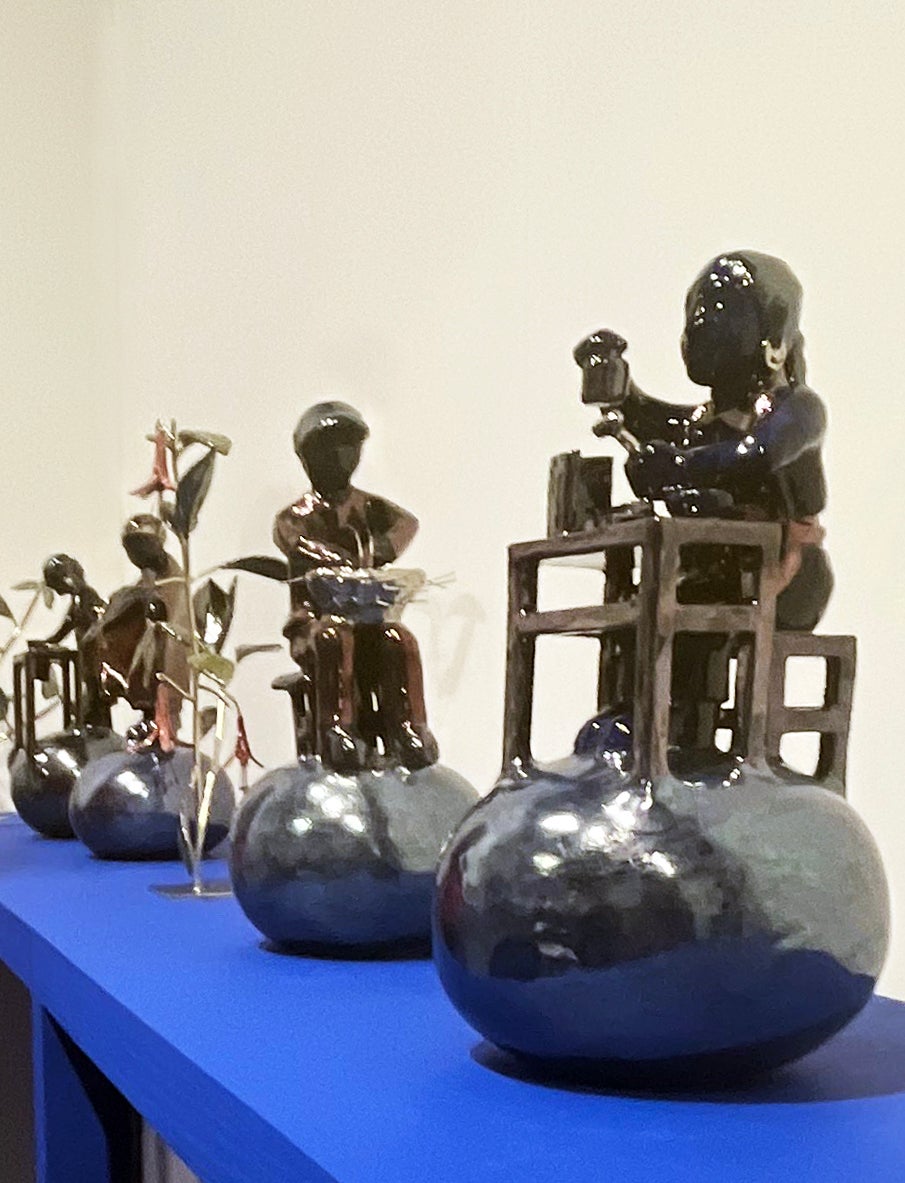
Ceramics from Calfuqueo's “Imagen País” (Country Image) series, from Galeria Marilia Razuk at Art Basel Miami. Photo by Cristina Verán.
CV: How do Mapuche cultural and historical understandings of gender factor into this, and the “language of the body” you’ve mentioned? Were you raised with this knowledge, to help you understand your own sense of self in a community context?
SC: I had no references at all for trans people when I was growing up, and the first trans-identifying person I met was not Mapuche. I longed to find reflections of myself in our history, and thus began what would become an ongoing area of research for me.
Christianity imposed this idea that the world is binary, but Mapuche recognized other life experiences. Mapudungun has many terms describing trans people, trans bodies in fact, but during the Spanish colonial era, these were deliberately reinterpreted with unfavorable implications to reflect the colonizing eye, no longer representing how Mapuche would have understood them.
Our word weye, for example, was translated derogatorily, akin to “ f*gg*t”; something nefarious. Colonial chronicles I’ve found in my archival research speak of our machi weye (machi = healers)—who shift between the feminine and the masculine—as “invoking the devil,” because that’s how homosexuality and homoerotic desire, as well as transvestism, were understood by Europeans at the time. But my ancestors recognized that some people can transcend the gender ascribed by their biology. It’s a complex conversation that I feel is very important to put back into circulation and to talk about within my community.
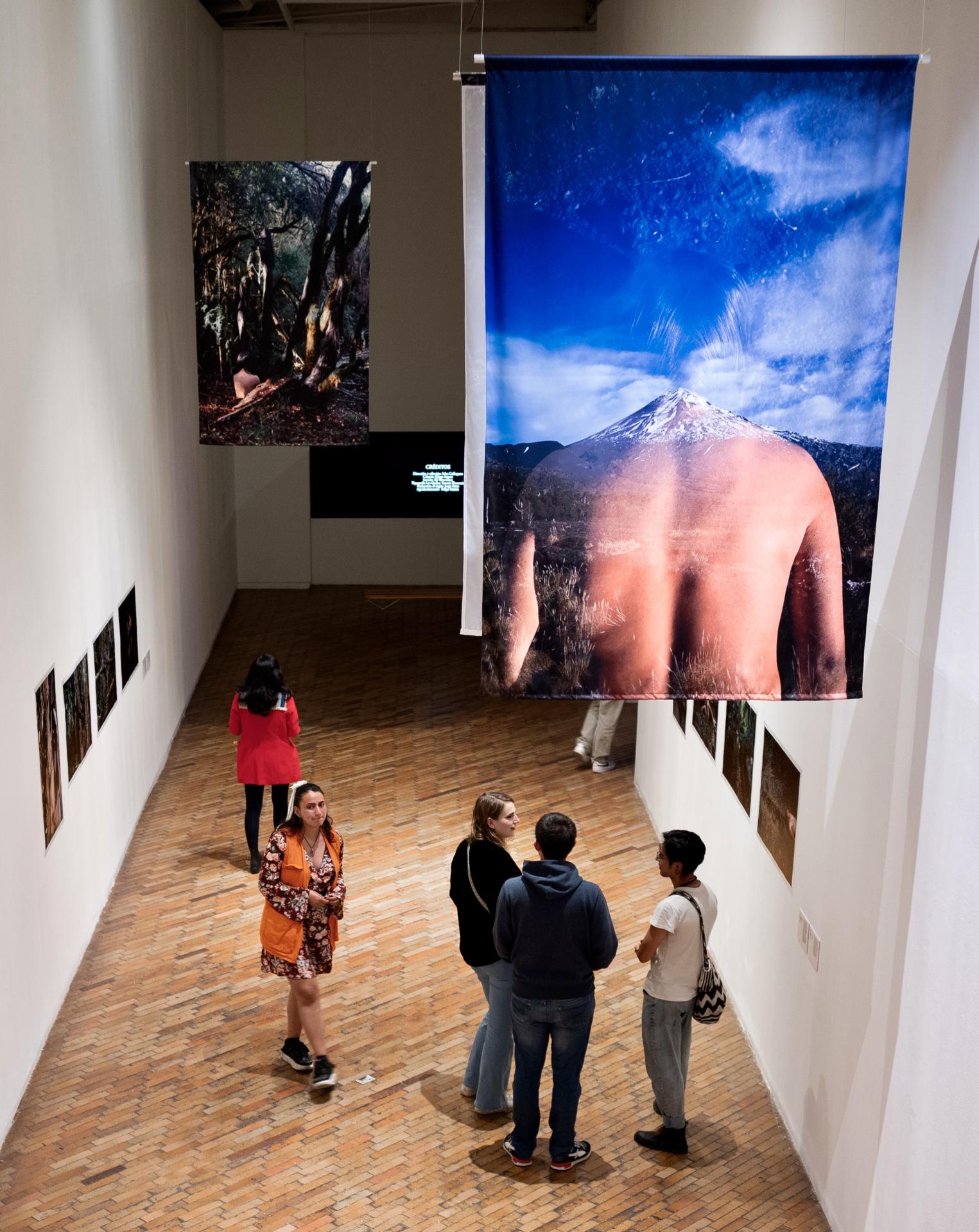
Scene from "Antü Ñi Kuram (Huevo del Sol/ Sun's Egg)" - Seba Calfuqueo's new solo exhibition at MAMBO (Museo de Arte Moderno de Bogotá) in Colombia. Photo by Diego Argote.
CV: I imagine then that you’ve explored this theme further in your art. Please share an example, and describe how you chose to bring it to life .
SC: My very first performance, back in 2015, was a powerful piece called "You Will Never be a Weye." It begins with embodying a character much like my grandmother—a very important reference in my work—who insists, when a transvestite nephew comes to visit her, that there were “no f*gg*ts” in the Mapuche tradition. From there, I link my family history with the political and social contexts that led to the erasure of machi weye from Chile’s history—as well as, closer to home, the denial of there even being or having ever been any trans people in my own family.
CV: Given how they have influenced your art, how have they responded to your work? Do you discuss it with them?
SC: The first time I performed in public, I brought my whole family, making sure that they were well prepared for what they would see: a simple, unpretentious work with strong emotional content. They didn’t really understand what was happening, but they did grasp its purpose, its essence.
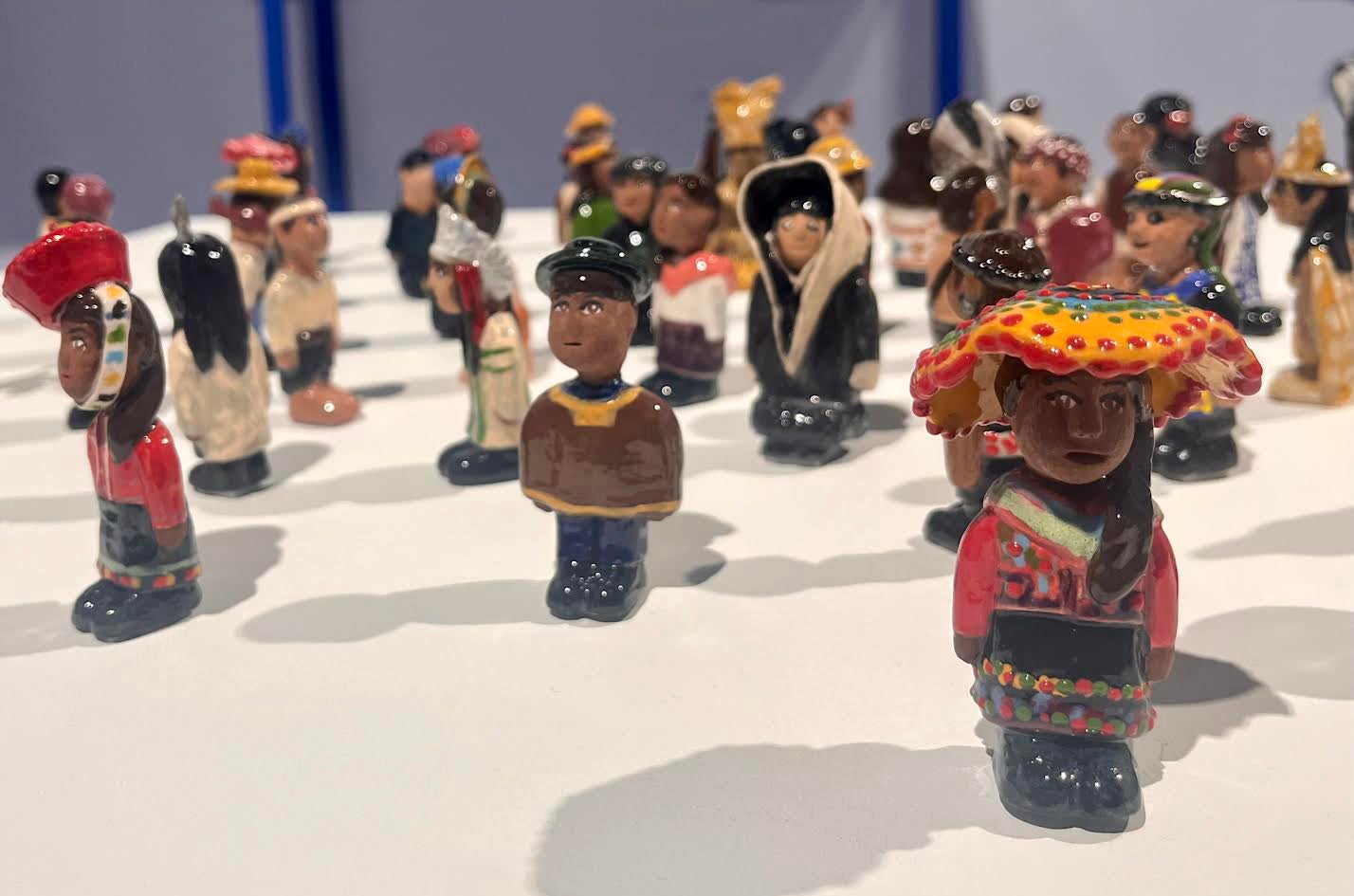
Seba Calfuqueo was featured in a solo exhibition with Galeria Marilia Razuk of São Paolo at Art Basel Miami. Photo by Cristina Verán.
CV: Your practice is distinctive and quite prodigious in terms of creative output, scope, and format. How, as a multi-disciplinary practitioner, do you decide which format works best to bring a particular idea to fruition?
SC: As a project artist, rather than a technical artist, I think first about what I want to convey, conceptually, then at which audience it will be directed. For something narrative that tells a story, I use video. To create something more sensitive, something that talks about the body, I use performance. For an idea focused on objects, I use ceramics. And if I want to make something more representative, I will use painting.
CV: What kinds of creative and activist communities have been important for you, and how have these networks factored into your journey within and beyond Chile?
SC: I’m part of Colectivo Mapuche Rangiñtulewfü, which publishes Yene Magazine and connects Indigenous activists and those who are Afro-descended or with a migrant experienc throughout Wallmapu (the ancestral Mapuche territories of Chile and Argentina) and across and from the other side of the Andes. The global network of Indigenous filmmakers and film festivals, too, has been a real bridge for me to other Indigenous creators as well as to explore other kinds of media for my work and to share my video projects in spaces apart from the traditional art world.
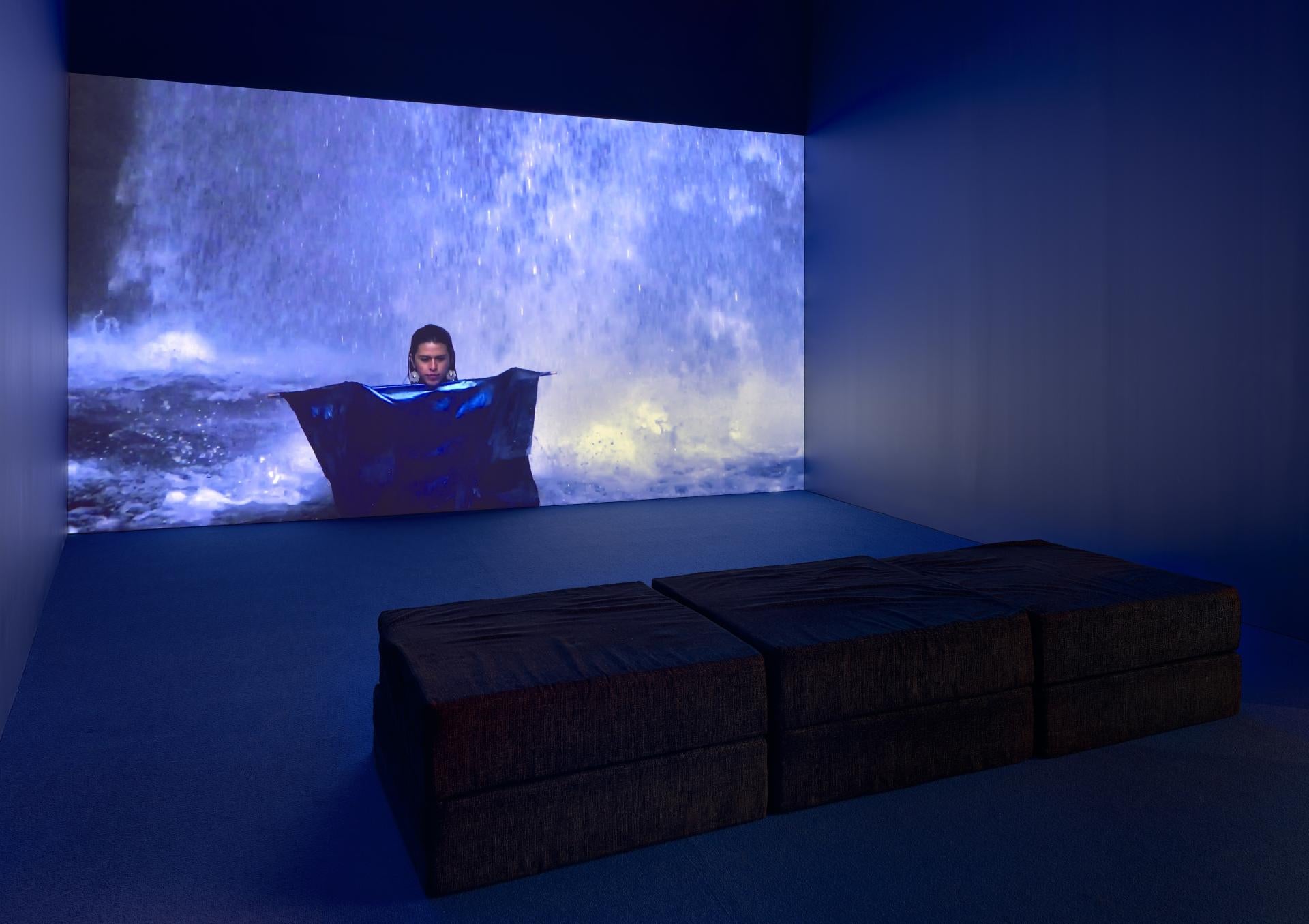
Scene from the video installation "Tray Tray Ko", at the 2024 Whitney Biennial in New York.
CV: In what has been a truly phenomenal year for you—and indeed for any artist, Indigenous or not—what do you make of all the attention, in the context of your career thus far?
SC: It’s all been very intense, seeing such a major shift in how my work is perceived in the art world and how my art is reaching places with more visibility than ever before. It’s the culmination of more than 10 years of hard work and effort, and definitely also thanks to the support of the galleries (which includes Galería Marilia Razuk in São Paolo and Galería Patricia Ready in Santiago) who circulate my art out there.
In what I see as a historic moment for Indigenous contemporary art, artists like me getting to occupy spaces that were historically denied to us feels—in both a both personal and collective sense—like vindication.
Seba Calfuqueo’s latest exhibition, "Antü Ñi Kuram (Huevo del Sol/ Sun’s Egg)" will be on view from March 13, through June 1, 2025, at MAMBO (El Museo de Arte Moderno de Bogotá) in Colombia.
Cristina Verán is an international Indigenous Peoples-focused specialist researcher, educator, advocacy strategist, network weaver, and mediamaker. She was a founding member of the United Nations Indigenous Media Network and the Indigenous Language Caucus. As adjunct faculty at New York University's Tisch School of the Arts, she brings emphasis to the global histories, expressions, and socio-political impacts of Indigenous popular culture alongside contemporary visual and performing arts. She is originally from Peru.
Top photo: Seba Calfuqueo with "Tejedor de la imagen, Tecnologías de la imagen" (Weaver of the Image, Technologies of the Image), featured in her solo exhibition with Galeria Marilia Razuk of São Paolo at Art Basel Miami. Photo by Cristina Verán.
